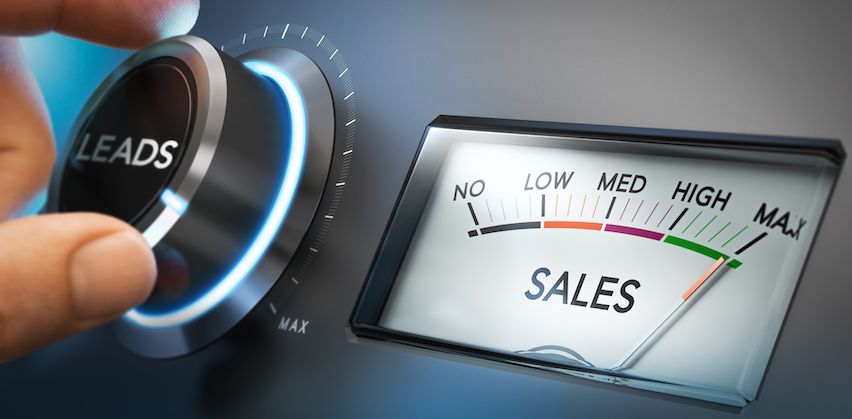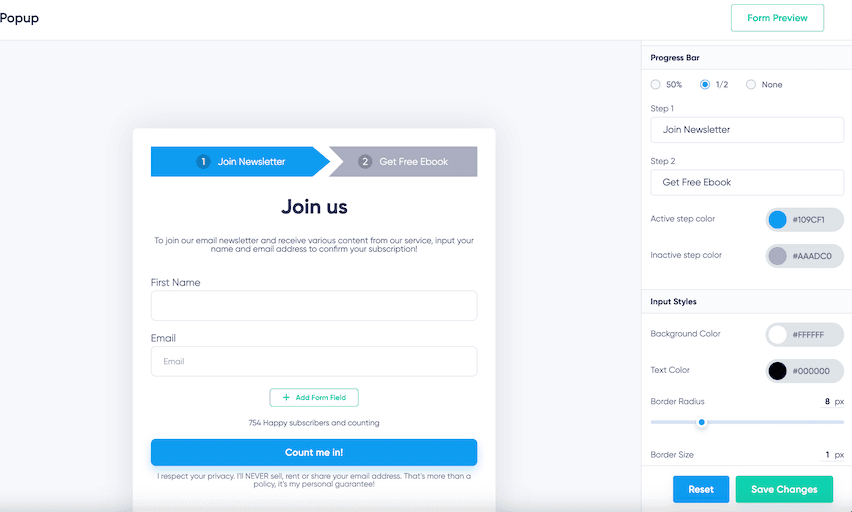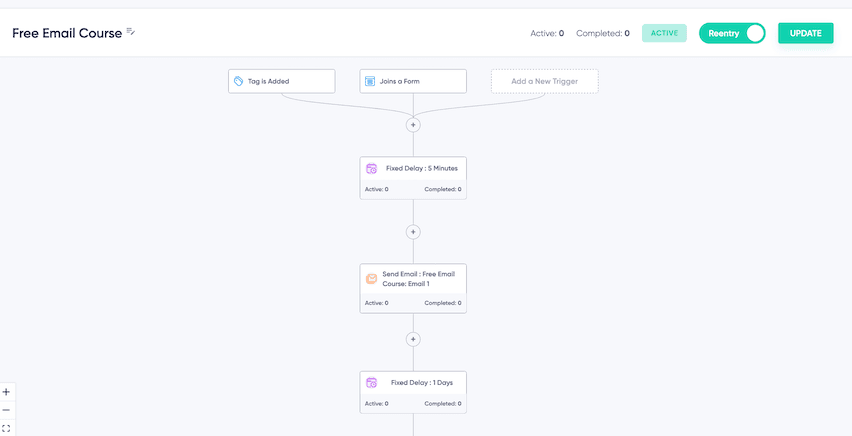Contents
the email tool that makes email marketing simple
B2B Email Marketing: A Comprehensive Guide for Business Growth
Published: March 27, 2025
B2B (business-to-business) email marketing is a targeted strategy designed specifically for business interactions. Unlike broad campaigns aimed at consumers, B2B email marketing campaigns focus on the specific needs and challenges of businesses. They go beyond mass advertising and deliver content that is relevant, informative, and directly aligned with the target audience's interests.
The main difference between B2B and B2C (business-to-consumer) email marketing lies in their goals and approaches. B2C marketing aims to reach a broader audience, while B2B marketing aims to build lasting professional relationships and strategic partnerships. It requires a deep understanding of the business sector to tailor messages to resonate with key decision-makers in different industries.
B2B email marketing is critical to business growth. More than just a sales tool, it is a long-term investment in building relationships, enhancing brand reputation, and building trust with potential and existing customers. In today's competitive business world, successfully nurturing leads and building lasting relationships is critical to sustainable growth and market presence.
This guide looks at the intricacies of B2B email marketing and the role it plays in growing your business and strengthening your company's market position.
What Is B2B Email Marketing?
Understanding Email Marketing
Email marketing is a digital marketing strategy that uses email to promote a company's products or services.
It serves various purposes, such as promoting new products, offering discounts, and educating the audience about the value of the brand.
This marketing method is an effective tool for maintaining customer loyalty, building relationships, and boosting sales.
Whether used in inbound marketing or as part of a larger automation, email marketing helps with lead nurturing, brand awareness, and customer relationship management.
Distinguishing between B2B and B2C
Before you delve into B2B email marketing, you should know the difference between B2B (business-to-business) and B2C (business-to-consumer) marketing.
B2B Marketing: B2B marketing targets the needs, interests, and challenges of people buying on behalf of or for their organization (i.e., the company they work for). This makes the company the customer.
B2C Marketing: In contrast, B2C marketing focuses on individual consumers who buy products or services for personal use.
The special requirements of B2B customers for email marketing
B2B email marketing fulfills different requirements than typical email marketing or B2C approaches. It is important to understand what characterizes B2B customers.
Need detailed and professional communication: Customers require comprehensive and professionally prepared information. This is because they need to make informed decisions that significantly impact their business.
Focus is on building long-term relationships: Unlike B2C, which is often transactional, B2B marketing is about building lasting relationships. This is because B2B transactions usually have more at stake and more investment.
Trust and commitment are important: B2B decision-making processes are usually lengthy and require sustained commitment. The challenge is to maintain companies' interest and trust as they invest a lot of time and resources.
Need to adapt to the individual company: The diversity of business needs and goals in B2B requires a highly customized approach. B2B marketing emails need to be tailored to the unique challenges and goals of each individual business.
Complexity of decision-making processes: A common challenge in B2B marketing is engaging with multiple decision-makers, each with different roles and preferences.
Lengthy sales cycles: The long duration of B2B sales cycles demands a consistent and effective communication strategy.
By outlining these unique needs and challenges of B2B buyers, we lay the groundwork for later sections where we look at strategies that effectively address and leverage these issues.
Next, we'll look at the benefits of email marketing for B2B and how it contributes to business growth and success.
Benefits of B2B Email Marketing
Lead generation
Lead generation is an important part of B2B digital marketing. It allows companies to connect with potential customers and expand their professional network. Effective campaigns target the right companies, creating opportunities for new and profitable business relationships.
Customer retention
In B2B marketing, retaining existing customers is just as important as acquiring new ones. Email marketing supports this by keeping existing customers loyal to your company. Regular, personalized communication via email helps maintain a strong bond with your customer base and ensures ongoing business and repeat transactions.
Brand awareness
A strong brand presence is essential in the B2B market, and email marketing effectively achieves this. Consistent email communication keeps your brand in your customers' minds. Various forms of marketing emails, such as newsletters and product updates, will reinforce your brand identity and values and increase visibility in a competitive market.
Build long-term relationships
Building and maintaining long-term relationships is crucial in powerful B2B marketing. It enables ongoing, appreciative communication that builds trust and reliability. Providing relevant content and responding promptly to customer feedback helps generate loyalty and forge long-term business relationships.
Measurable results and analytics
A major benefit of email marketing is the ability to measure results. Analytics provide insights into email performance, with metrics such as open rates and click-through rates providing information on customer engagement. This data helps you fine-tune business strategies and optimize your email outreach to improve engagement and results.
Cross-selling and upselling opportunities
Building on the analytical insights we discussed in the previous section, email marketing offers significant opportunities for cross-selling and upselling, potentially increasing revenue from each customer. By analyzing customer data and previous interactions, you can tailor your content to suggest complementary products or higher-value services. This strategic approach increases sales and customer satisfaction by offering solutions that are relevant and responsive to customers' changing needs.
Understanding the many advantages of email marketing, from boosting sales to reaching people around the world, is just part of the picture. It's important to see how these efforts fit into your bigger marketing plan. Next, we'll look at how to ensure your B2B email marketing works well with your overall marketing activities, helping you get the most out of your efforts.
How to Align B2B Email Marketing with Your Overall Marketing Strategy
Understand the goals of B2B marketing
Clearly define your B2B business goals. These may include generating leads, enhancing customer engagement, or building thought leadership. Tailor your email marketing to align with these varied goals.
Segmentation and targeting in B2B
Go beyond basic demographics for segmentation in B2B. Group your audience by company size, industry, decision-making role, and buying behavior for more effective email content. Regularly evaluate these segments as market dynamics change.
Tailor emails to the B2B buyer's journey
Align your emails with each stage of the B2B buyer's process, addressing the specific needs and concerns at various stages like awareness, consideration, and decision. Focus on business challenges and opportunities relevant to each stage.
Integrate with B2B sales strategies
Ensure close collaboration between your marketing and sales teams for aligned email strategies. Use B2B newsletter campaigns to nurture leads with informative content and provide sales teams with insights from email interactions.
Customized B2b content strategy
Develop a content strategy for your emails that resonates with your audience. Mix educational content with case studies and success stories, focusing on solutions to business-specific problems rather than just product features.
Use data for B2B insights
Employ data analytics to determine which content performs best with your audience. Regular data reviews help you quickly adapt your B2B strategy to market trends and feedback.
Synergy with other marketing channels
Coordinate your email marketing with other B2B channels such as industry forums, webinars, and social media platforms such as LinkedIn or Twitter. A multi-channel approach that utilizes the strengths of the various social media platforms enriches the customer experience and reinforces your messages.
Adapt to the changing needs of the B2B market
Stay agile in your strategies to keep pace with rapid changes in the B2B landscape, technological advancements, and evolving customer preferences.
Regularly review and adjust performance
Continuously assess your campaign's effectiveness within your broader B2B strategy. Use performance metrics for assessment and predictive planning to ensure ongoing alignment with business goals.
After figuring out how to match email marketing with overall business goals, it's time to look at some smart ways to make your email marketing even better. Next, we'll discuss some great tips and tricks that can help you get the most out of your B2B email marketing and ensure it works for your business.
Strategies and B2B Email Marketing Best Practices You Should Follow
Effective B2B email marketing requires a strategic approach tailored to meet business customers' unique challenges and requirements. Here are some key strategies and best practices to optimize your email campaigns:
Understand and address customer needs
- Deep insight: As a B2B marketer, gain a deep understanding of your B2B customers' needs, challenges, and decision-making processes. Research their industry, market trends, and specific business pain points.
- Tailored content: Develop email content that addresses these insights. Offer solutions, industry knowledge, and relevant information that aligns with their specific business environment.
Nurture long-term relationships
- Consistent communication: Keep in touch with your audience regularly through emails that add value, rather than just sell. Share insights, industry news, and helpful resources.
- Value-driven approach: Focus on how your services or products can help them achieve their business goals. Include case studies, testimonials, or success stories that demonstrate the long-term benefits of partnering with your company.
Personalize and segment
- Partition your audience: Divide your subscriber list based on criteria like industry, company size, or position in the sales funnel. This allows for more targeted and relevant communication.
- Personalize your messages: Use the data you have about each segment to tailor your emails, addressing the unique needs and interests of different groups within your audience.
Engage decision-makers effectively
- Multi-stakeholder targeting: Recognize that B2B decisions often involve multiple stakeholders. Craft emails that cater to the varied interests of these groups, from technical details for IT staff to ROI and bottom-line benefits for executives.
- Feedback loop: Encourage responses and feedback to your emails. Use these to refine your approach and ensure you are addressing the concerns and needs of all decision-makers.
Integrate with sales and email marketing initiatives
- Align strategies: Ensure that your email marketing initiatives sync with your overall sales and marketing initiatives. Your emails should reflect and support the broader goals of your marketing and sales campaigns.
- Support the sales journey: Use email marketing to nurture leads through the sales funnel. Provide information and resources relevant to each stage of the buyer's journey.
Measure and adjust based on performance
- Focus on metrics: Track metrics that are most relevant to B2B goals, such as engagement with specific content, lead progression, and conversion rates.
- Continually improve: Regularly review these metrics to understand what works and what doesn't. Use this data to refine and improve your B2B email content strategy.
By implementing these strategies, you can develop a B2B email marketing approach that addresses the specific challenges of the domain and leverages its unique opportunities for business growth and relationship building. The key is to focus on the long-term value and partnership, rather than just short-term sales, ensuring that your email marketing efforts contribute significantly to your overall business objectives.
Now that we've gone over the key strategies for B2B email marketing, it's time to look at something more advanced. Next, we'll get into techniques that can take your email marketing to the next level and set you apart from the competition.
Advanced Strategies in B2B Email Marketing
It's not enough to stick to the basics. Advanced strategies can significantly improve your strategy and give you a competitive edge. Let's take a closer look at these tactics and understand how they can be used effectively in a B2B context.
Optimization with A/B tests
A/B testing is a powerful tool in the arsenal of B2B email marketers. By comparing two versions of an email, you can find out which elements work best – be it the subject line, the email copy, or the call to action. These tests find out what resonates well with your customer base and lead to better engagement and conversion rates. By regularly testing different aspects of your emails, you ensure that your strategy evolves with your audience's preferences.
Mobile optimization: Essential in today's marketplace
In today's fast-paced business world, your audience is likely to read emails on the go. Optimizing your emails for mobile devices is no longer just an option; it's a necessity. Mobile-friendly email designs with responsive layouts and easy-to-click buttons are key to keeping your busy B2B customers engaged. Neglecting this aspect can lead to lower email opens and missed opportunities.
More than basic CTAs: Creative engagement
In B2B email marketing, the call to action (CTA) is more than just a button or a link; it's an invitation to engage further with your brand. Innovative and creatively designed CTAs can significantly increase the click-through rate. For example, a CTA offering a free industry report or an invitation to an exclusive webinar can be more appealing to business people than a simple "buy now" button.
Interactive content: Actively engaging the target group
If you incorporate interactive elements such as surveys or interactive infographics into your emails, you can significantly increase engagement. These elements make the email not just a message but an experience. For B2B audiences, where the decision-making process is more complex, interactive content can provide valuable insights while maintaining audience engagement.
Using predictive analytics for improved targeting
Predictive analytics allows you to anticipate your customers' future actions based on their past behavior. With this approach, you can better tailor your emails to the needs and interests of your customers and target them with content that matches their potential needs and interests. For example, you can use predictive analytics to find out which customers are most likely to be interested in a particular product upgrade or service.
Dynamic content for personalized experiences
Dynamic content changes based on the recipient's data, preferences, or actions and allows for a high degree of personalization. In a B2B context, where personalized emails are crucial, dynamic content can increase the relevance and appeal of emails. This includes, for example, personalized greetings, content tailored to the recipient's industry, or offers based on their purchase history.
Behavioral triggers: Timeliness and relevance
Behavioral triggers in email marketing mean that automated emails are sent based on specific actions taken by your customers. This could be visiting a specific page on your website or downloading a resource. In B2B, where sales processes are longer, these triggers can engage potential customers at key decision stages.
Integrating email with other business tools
Integrating email marketing with CRM and other business tools is essential for effective campaign management. This integration facilitates a seamless flow of customer data across platforms, enhancing your ability to understand and track customer interactions. Linking your newsletter campaigns with CRM systems offers valuable insights into customer behavior, allowing for more accurate targeting and decision-making. This synchronization makes your marketing initiatives more coherent and significantly increases their impact by ensuring data-driven campaign execution.
Now that we've covered advanced email marketing tactics, let's turn our attention to a key component of these efforts: the B2B email list. Building and maintaining this list is critical to effectively communicating with business decision-makers. Below, we'll look at strategies for building a strong and engaging list.
Building and Maintaining B2B Email Lists
In B2B marketing, your subscriber list is indispensable for getting in touch with decision-makers and multipliers. You must focus on the list's relevance and engagement rather than just its size. Here's how to effectively build and maintain a B2B subscriber list.
Targeted Growth
Focus on attracting contacts who are key decision-makers or influencers in their organization. Use resources such as industry reports or exclusive webinars as lead magnets to ensure your list is filled with engaged and relevant professionals.
Regular List Maintenance
Purge your list regularly to remove inactive subscribers. This step is important in a B2B context to achieve high email deliverability and engagement rates and ensure your content reaches the right audience.
Content Tailored to Business Needs
Your emails should focus on the specific challenges and interests of your audience. Provide solutions and insights through a compelling case study, complemented by a detailed industry report and actionable advice. This approach ensures that your content is informative plus demonstrates your expertise and commitment to practical solutions as a trusted business partner.
Strategic Segmentation
Segment your list based on factors such as industry, company size, or function. This allows you to effectively tailor your communications and create personalized and relevant email newsletter campaigns for the different segments of your audience.
Write Compelling B2B Email Subject Lines
The subject line is your first point of contact. They should be clear, interesting, and relevant to the business interests of your audience. Effective subject lines increase the open rate and are a decisive factor in the success of your campaigns.
Optimal Timing
Consider the best times to send emails, which may differ from consumer strategies. Schedule your emails so that they are most likely to be read by professionals, such as during business hours or when most decisions are being made.
Professional Design
Ensure every email has a professional design that reflects your brand's seriousness and quality. A clean, straightforward layout will help present your content clearly and effectively.
Performance Analysis
Track your emails' performance, focusing on metrics relevant to business marketing, such as engagement on product pages or whitepaper downloads. Use these insights to continuously improve your strategies.
With these strategies for building and maintaining a high-quality B2B subscriber list, it's important to evaluate the effectiveness of your marketing initiatives. The following section is all about measuring the success of your campaigns and understanding their impact on your business goals.
Measuring Success in B2B Email Marketing
Evaluating the effectiveness of B2B email campaigns requires a detailed analysis of specific metrics and the strategic use of data analytics. This step goes beyond basic measurements and provides deeper insights that reflect the unique nature of B2B interactions and long-term business relationships.
Advanced performance indicators
Lead quality analysis: Shift the focus from pure lead quantity to evaluating lead quality. Assess how leads from campaigns compare to leads from other channels in terms of engagement and conversion potential.
Customer journey mapping: Track how email interactions influence the B2B customer journey. Analyze at which stages email marketing is most effective and identify potential gaps that can be filled with tailored content.
ROI in the context of long-term value: Look at ROI not only in terms of immediate sales but also in terms of contribution to long-term customer relationships and brand loyalty.
Sophisticated data analytics application
Trend analysis over time: Use data analytics for longitudinal trend analysis. Understand how audience responses to campaigns evolve and indicate changes in market dynamics or preferences.
Predictive behavior modeling: Don't just analyze past behaviors. Use predictive analytics to forecast future customer actions and tailor your campaigns to meet changing needs.
Advanced segmentation insights: Use data to refine target group segmentation. Identify micro-segments within your B2B target group for highly targeted campaigns.
Keeping pace with the dynamics of B2B email marketing
If you want to stay ahead in B2B email marketing, you need to adapt quickly to the changing business environment. By continuously evaluating your campaign data, you can keep up with changing customer expectations and market trends and ensure your b2b strategy remains relevant and effective.
Adaptive content strategies: Develop a dynamic content strategy based on ongoing data analysis and ensure that your emails always address the current and emerging needs of your B2B customers.
Agility in execution: Maintain an agile approach to email marketing that allows you to quickly change your strategy in response to real-time market feedback and analytical insights.
By focusing on these advanced aspects of measuring success, you'll ensure that your B2B email marketing is effective in the short term AND sustainable and adaptable in the ever-changing business landscape.
With a solid understanding of how you can measure and analyze the success of your B2B email campaigns, let's move on to the practical applications. In the following section, we present various email examples of B2B marketing. These practical applications show how the strategies and principles discussed can be effectively implemented to strengthen professional relationships and achieve business goals.
Best B2B Email Marketing Examples
Every communication is an opportunity to strengthen professional relationships and advance business goals. Below we present different types of emails commonly used in a B2B context, explaining their purpose and effectiveness while emphasizing email personalization to meet the unique needs of each recipient.
Welcome email
This email sets the tone for your new relationship. Utilizing a well-crafted email template here can help introduce your company effectively and outline what subscribers can expect, including any introductory offers. A well-worded welcome email in a professionally designed template builds trust and encourages new subscribers to engage with your content.
Example
Subject: Welcome to [Your Company Name] – Your Partner in Growth!
Dear [Recipient's Name],
We're excited to have you join our community at [Your Company Name]. Our mission is to empower businesses like yours with [brief description of products/services]. Here's what you can expect from us:
- Regular updates on industry trends and insights
- Exclusive access to our new product releases and services
- Invitations to webinars and events for professional development
As a welcome gift, we're offering you [mention any special offer or discount]. Explore more about us [link to website or a specific page].
Best regards, [Your Name and Title]
Announcement email
Use this type of email to communicate important company news, product launches, or service updates. An announcement email keeps your customers informed about the developments of your company and emphasizes your commitment to growth and improvement.
Example
Subject: Exciting News: Launching Our New [Product/Service]!
Dear [Recipient's Name],
We are thrilled to announce the launch of our latest [product/service], designed to revolutionize the way you do business. [Briefly describe the new offering and its benefits].
Stay tuned for more updates and how you can make the most out of this new addition!
Best, [Your Company's Team]
Event email
This email is a vital part of your B2B email strategy, as it's needed for promoting webinars, workshops, or conferences. It should contain the most important information about the event, highlight the benefits for participants, and include a clear call to action, such as registering for the event or learning more about it.
Example
Subject: Join Us at Our Annual [Industry] Conference – [Event Name]
Dear [Recipient's Name],
We are excited to invite you to our annual [Event Name], a premier conference for [industry/profession] professionals. This event will take place on [date] at [location].
Why You Should Attend:
- Engage with industry leaders and experts.
- Participate in hands-on workshops and seminars.
- Network with peers and explore new business opportunities.
Don’t miss out on this opportunity to gain valuable insights and connect with your industry community.
Register now [link] to secure your spot and be a part of this transformative experience.
Looking forward to meeting you there!
Best, [Your Company's Name]
Webinar email
This email, promoting online events, should emphasize the event's topic, the speakers' expertise, and the benefits for participants. To be effective, it must create excitement and anticipation for the upcoming event.
Example
Subject: Don't Miss Our Upcoming Webinar on [Topic]!
Dear [Recipient's Name],
We're hosting a webinar on [Topic] featuring [Speaker Name], a renowned expert in [field]. This session will provide actionable insights on [brief description of what the webinar will cover].
Reserve your seat now [link].
Best wishes, [Your Company's Team]
Survey email
This email collects feedback. It should clearly state the survey's purpose and how the feedback will be used. If possible, it should offer an incentive to complete it. A survey email provides valuable insight into customer preferences and experiences.
Example
Subject: We Value Your Feedback – Take Our Quick Survey
Dear [Recipient's Name],
Your opinion matters to us! Please take a moment to fill out our brief survey [link] and help us improve our services. As a token of appreciation, you’ll receive [incentive].
Thank you for your valuable input!
Best, [Your Company's Team]
Sales email
This email aims to persuade potential customers. It should be personalized and emphasize how your product solves the recipient's specific business challenges. A compelling sales email is direct, persuasive, and spotlights your offer's unique value proposition.
Example
Subject: Elevate Your Business with Our [Product/Service]
Dear [Recipient's Name],
Discover how our [Product/Service] can address your business needs and streamline operations. With [highlight features and benefits], it's designed to enhance your productivity.
Contact us for a personalized demo or more information.
Best regards, [Your Sales Team]
Follow-up email
This email is used to re-engage with contacts after they have interacted with your content, such as downloading a resource or engaging with an online campaign. It's an opportunity to provide additional value, reinforce your message, and encourage further action.
Example
Subject: Thanks for Engaging with Us! Discover More Resources
Dear [Recipient's Name],
Thank you for showing interest in our resources and services. We're delighted to see your engagement and are here to offer further insights and support for your [specific business need or interest].
To enhance your experience, we've curated additional resources you might find useful:
- [Link to a related blog post or article]
- [Link to a detailed guide or white paper]
- [Information about related services or products]
If you have any questions or require more detailed information, please feel free to reach out. Our team is dedicated to assisting you in achieving your goals.
We're excited to be a part of your journey and look forward to further collaboration.
Warm regards, [Your Company's Team]
Update email
This email informs your customers about changes or improvements to your products and services. Transparency and clarity in an update email maintain trust and keep customers loyal to your offering.
Example
Subject: New Updates to Enhance Your [Product/Service] Experience
Dear [Recipient's Name],
We're excited to announce new updates to our [Product/Service]. These improvements [briefly describe updates] are designed to enhance your experience and efficiency.
Check out the details here [link].
Best,
[Your Company's Team]
Business email
This email is used for professional communication, such as for partnership offers or service requests. It should be clear, concise, and reflect the professional tone of your brand.
Example
Subject: Let's Collaborate for Mutual Success - Opportunities at [Your Company]
Dear [Recipient's Name],
At [Your Company], we are always looking to forge new paths and collaborate with forward-thinking organizations. We believe that together, we can achieve greater success and drive innovation in our respective fields.
We have recently identified several opportunities for collaboration in areas such as [list general areas of collaboration or mutual interest]. These opportunities are designed to create synergy between our companies and provide substantial benefits.
If you're interested in exploring these possibilities and learning more about how we can work together, we invite you to [specific call to action, such as visiting a landing page, filling out a partnership interest form, or attending a webinar on collaborative opportunities].
We are excited about the prospect of collaborating with your team and look forward to the opportunity to discuss our mutual goals.
Best regards,
[Your Company's Team]
Email about new features
When introducing new features, focus on their benefits for the customer's business. Include clear, actionable information about how customers can effectively use these features to improve their business operations.
Having looked at the different facets of great B2B email marketing, we'll next see how Maildroppa addresses these specific needs and offers solutions to help businesses navigate and thrive in the evolving landscape of email marketing.
Example
Subject: Introducing the Latest Features in [Your Product/Service]!
Dear [Recipient's Name],
We're thrilled to bring you the latest updates to [Your Product/Service]! Our team has been working hard to enhance your experience, and we're excited to share these new features with you.
What's New:
- [Feature 1]: [Brief description of the feature and its benefits].
- [Feature 2]: [Brief description of the feature and its benefits].
- [Feature 3]: [Brief description of the feature and its benefits].
These updates are designed to [explain how the new features improve the product/service].
To help you get started, we've prepared a quick guide [link to a resource or tutorial] on how to make the most of these new features.
We're always striving to improve [Your Product/Service] and we'd love to hear your thoughts. After you've had a chance to try them out, let us know what you think!
Best regards, [Your Company's Team]
Maildroppa - Your B2B Email Marketing Solution
As we conclude our in-depth discussion of B2B email marketing, it's clear that having the right marketing tools is crucial to success. This is where Maildroppa comes in – offering an innovative and efficient solution for your email marketing needs.
Maildroppa's user-friendly visual form builder allows for the quick creation of subscription forms that seamlessly integrate into your sales funnel. These forms collect email addresses, make a positive first impression, and engage potential subscribers from the first interaction with your brand.
Customization is a huge aspect of Maildroppa, especially when it comes to the signup process. You can customize everything from privacy settings to GDPR compliance to ensure your campaign complies with legal standards and appeals to your audience. This includes the ability to customize the text of the GDPR agreement – a feature that is particularly beneficial for companies operating in or targeting the European market.
Maildroppa's reporting tools provide valuable insights into signup views and conversion. These reports help fine-tune your strategies to increase engagement and improve conversion rates.
With Maildroppa, campaign management becomes a breeze. Whether you're looking to dispatch emails for a newsletter campaign instantly or schedule them for future delivery, the platform streamlines these tasks. This ease of use allows you to significantly save time, shifting your focus towards crafting engaging content and honing your B2B email marketing strategy.
At the heart of Maildroppa's email marketing software is a focus on personalization and segmentation. By effectively segmenting your email list with this software, you can ensure that each group receives content that is most relevant and interesting to them.
Maildroppa's visual automation and sequence builder
Maildroppa's visual automation and sequence builder is a powerful tool that allows you to easily create sophisticated email marketing automation and sequences without any coding knowledge.
Drip campaigns are particularly effective, allowing you to engage with your B2B audience longer. These campaigns schedule a series of emails based on specific triggers or time intervals and are perfect for nurturing leads and delivering educational content.
With the Maildroppa visual automation builder, you can set up these automated campaigns to automatically send tailored content at the right time in the customer journey.
Maildroppa focuses on quality and reliability in every respect. The attention to detail and ease of use, backed by German engineering, make Maildroppa a reliable partner for your email marketing.
Conclusion
As we conclude our comprehensive guide to successful B2B email marketing, we hope you've found a wealth of practical content marketing tips. In the landscape of B2B email marketing platforms, Maildroppa stands out with its advanced features, ease of use, and commitment to data security, making it the ideal choice for companies looking to improve their B2B communications and deepen their business relationships.
Maildroppa's ease of use, comprehensive feature set, and affordability make it particularly attractive to small and medium-sized businesses and solo founders.
Maildroppa's platform simplifies complex email marketing tasks and ensures effective audience targeting. This is an invaluable advantage in today's competitive digital landscape.
For companies looking to improve their B2B engagement, Maildroppa offers an accessible yet robust platform. Maildroppa is the ideal partner for anyone looking to make a mark with their email marketing and grow their business relationships.







